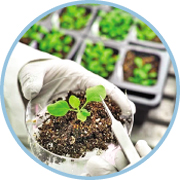 Is biotechnology the next best resort to reach the desired levels of agricultural productivity? With the fast-increasing hungry mouths worldwide, the need to ensure food for all does call for methods to raise agricultural productivity twice its current state in the next decade or so.
Is biotechnology the next best resort to reach the desired levels of agricultural productivity? With the fast-increasing hungry mouths worldwide, the need to ensure food for all does call for methods to raise agricultural productivity twice its current state in the next decade or so.
This has necessitated reinvigoration of agricultural research to increase crop productivity, and it is gaining more and more prominence not only in countries with farmland constraints but also in other nations where availability of land is no major problem. This is particularly so because innovations and technology have caused a huge watershed in crop productivity since the past decades necessitating a significant change in the patterns of cultivation, resulting in a manifold increase in the yield of crops of almost all varieties.
Gone are the days of conventional practices of cultivation reliant mostly on traditional knowledge handed down from generations. In Bangladesh, of late, the practice has attained a mix of conventional and semi-intensive methods of cultivation backed largely by positive experiments undertaken by the country's agro researchers. However laudable the efforts are, those barely go beyond innovation of newer seed varieties, use of fertiliser and the like. A great facilitator in the direction of boosting productivity is commonly believed to be the emerging genetically modified (GM) crops, cultured and fruitfully made use of by many countries. In a land-scarce country like ours with increasing population, raising productivity of agricultural products -- not just grains but a whole variety of horticulture products -- is crucial.
Agricultural productivity in the country has witnessed a sea change with grain production trebling between 1975 and 2020. Despite the laudable success, there are serious constraints to raising agricultural productivity due mainly to small holdings, declining soil fertility and various stress factors such as drought, flooding and intrusion of saline water. Besides, availability of cultivable land is declining because of urbanisation, construction of homesteads on crop fields in rural areas prompted by an increase in population and also land degradation. It has been estimated that currently the country has 8.3 million hectares of land available for crop production.
It is in this context that experts are strongly in favour of biotechnology to play an important role in increasing yield and addressing environmental stresses. Experts also hold the view that biotechnology provides powerful tools for sustainable development in agriculture, fisheries, livestock and forestry as well as the food and pharmaceutical industries.
It is quite clear that over the past several decades, technological developments and modernisation have grown concomitantly. Specifically, advances in genetic engineering have made possible the manipulation of crops to increase yield, ensuring food supplies for the increasing world population. The benefits of such agricultural modernisation have mostly favoured developed countries, whereas people living in developing and underdeveloped countries suffer widespread hunger, malnutrition and poverty. Hence, there is a necessity to create policies in order that the advances in biotechnology are translated into better agricultural practices that can meet the ever-growing food demand. The agricultural modernisation process, however, must consider that sustainable development is imperative in modern societies and that there is an increasing desire for consuming organic foods based on the idea that these foods have a higher quality and stimulate regional agricultural production.
Biotechnology has helped increase crop productivity by introducing such qualities as disease resistance and increased drought tolerance to the crops. Now, researchers can select genes for disease resistance from other species and transfer them to important crops.
Farmers use crop-protection technologies because they provide cost-effective solutions to pest problems which, if left uncontrolled, would severely lower yields. Crops such as corn, cotton, and potato have been successfully transformed through genetic engineering to make a protein that kills certain insects when they feed on the plants. In some cases, an effective transgenic crop-protection technology can control pests better and more cheaply than existing technologies.
Recognising the importance and impact of bio-technology in agricutural productivity, concerns have, however, been expressed from some quarters which feel that inadequate effort has been made to understand the problems in the use of transgenic crops, including their potential long-term impact. Genetically modified (GM) crops should be used for consumption after those have been subjected to rigorous tests to find if there are adverse impacts. This, no doubt, is a matter that should be looked into carefully and methodically. While there should not be any roadblock to innovations, it is important to remain alert to the adverse impacts that might accompany the brighter aspects of innovation and research. In Bangladesh, given that bio-technology is at a nascent stage, the country's researchers and scientists should bear with the odds, if any, while embracing innovations in this regard.
wasiahmed.bd@gmail.com